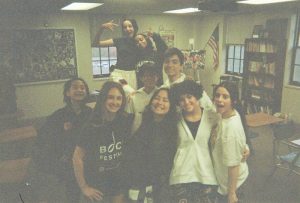As we begin to see patterns cycle through again, an age of largely disconnected nostalgia has begun to arise in the past few years. While most prevalent in fashion trends reflecting the eighties all the way to the late 2000s, popular styles have often mimicked that of the ‘90s and the 2000s in a widespread cultural nostalgia among the younger generations. Not only has this resurfaced in clothes, but also media such as movies and music. It’s no wonder that the way we capture memories and document our lives has also adopted this phenomenon. It’s hard not to see this, not only on social media, but also in real life as we see them around campus. But as we cycle back and forth through trends throughout the decades, it begs the question: just how far back does photography go as of consumer use? When we think of photography in history, it can feel like it just appeared suddenly. Moreover, in terms of what we know now as a modern or vintage camera, where does it trace back to and how far have we come?
The first photo was taken in 1816 by French inventor Nicephore Niepce, among his many experiments with camera obscura. Niepce worked with his brother Claude Niepce in experiments with light and permanent image capturing. He had studied the works of Carl Wilhelm Sheele and Johnn Heinrich Schulze on silver salt exposure and camera obscura. Niepce aimed to create a fixed image with these techniques, eventually using bitumen and pewter with his wooden camera obscura box and creating a permanent, albeit blurry, image. He named this heliography. Nicephore Niepce died in 1833, his research carried out through his colleague Louis Daguerre. In 1839, Daguerre continued to design the Daguerreotype, a photographic camera that produced a mirrored, but positive image, unlike the negatives from heliography. Daguerreotype cameras took a few minutes to hours, exposing a silver iodide film and later getting rid of any unchanged silver iodide with mercury vapor and heated saltwater. As technology advanced, this time was shortened. Later, the Daguerreotype camera became the first to be mass-marketed the same year it was designed.
Photographic cameras have come in many different forms throughout their history and marketing. The basis of the first widely marketed camera, the Daguerreotype, was largely derived from studies of camera obscura. Camera obscura is a phenomenon in which light is shone through a small hole in a material or a wall and projects a completely inverted image of the room in the opposite space. At around the same time as the Daguerreotype was the Calotype by Henry Fox Talbot. After its development in the 1830s, it was presented to the Royal Institute in 1839. With salt-soaked paper lightly brushed with silver nitrate, the chemical reaction to the light created a permanent image that used less time but produced a blurrier, negative image. In 1861, Thomas Sutton invented the single-lens camera that allowed the photographer to see the image taken through the camera via reflective lenses, similar to the early camera obscura devices. This, however, was an expensive technique. Kodac used the twin-lens to view a similar but slightly different image in the camera, as it was less expensive. The issue in funds for the lenses in cameras was similarly present in other companies. The cameras that we know today, digital, instant, and film followed in suite. 1888 produced the Kodac, a camera by American entrepreneur George Eastman, that held a roll of 100 photos that developed in a matter of seconds but couldn’t be exposed to light otherwise. The Kodac became widely accessible to the American public in 1900 and dominated the scene until digital cameras.
The first photo in color was taken by Thomas Sutton in 1961. By using red, green, and blue, any color could be produced within three monochrome plates. Photography in color became accessible in the mid-1960s after much experimentation with different chemicals, lenses, plates, and films. But before this, the all-important auto-focus camera came to fruition in 1978. Before a system of mirrors and sensors was implemented to determine the best distance between the film and the lens, the camera operator had to manipulate this distance manually. The Polaroid, a company by Edwin Land, had produced a camera that created photos instantly. By layering the negative and positive with processing film, when the negatives were removed, first by hand and later inside the camera, it gave a clear, positive image. Polaroid initially peaked in popularity and use in the seventies and eighties, dropping for the next few decades. What took its place in the top of the market during this time was the digital camera. While the idea of a digital camera had been floating around since 1961, one Steven Sasson at Kodak created the first prototype in 1975. At four kilograms, it took photos on a cassette tape and couldn’t print the photos nor be viewed without a special screen. This self-contained camera was much smaller than its predecessors and much more manageable. The advancement leaned on the CCD (“charged coupled device”) invented by Willlard S. Boyle and George E. Smith, which changed voltages once exposed to light. One of the first usages was in the satellite KH-11 by NRO in late 1976. Its photos were sent to and displayed to Philips Lab in New York on a specially constructed flat screen. Sasson’s prototype took 23 seconds to develop and displayed 100×100 pixels. It wasn’t until 1990 that the first digital camera came to the market. The Dycam Model 1, from Logitech, stored the photos on an internal storage of 1 megabyte of RAM. As this decade progressed, the rise of digital cameras only grew as digital software on computers increased in popularity, allowing the photos to be manipulated with image software without the need for dark rooms.

The 21st century has allowed photography to rise and become a staple to society. As seen throughout history, the need to document events and time through visual means has been constant. Camera obscura, a natural phenomenon of light, prompted the studies and subsequent invention of the first fixed image by Nicephore Niepce. Louis Dagguere, his colleuge, carried out his studies in the Dagguerreotype. As decades passed, inventors aimed to shortent he amout of time needed for exposure for the photo to develop. This came in forms of paper brushed with silver salts and film. So when the first photo in color was taken in 1961, it’s no surprise that incredible advancements were made soon after. The Polaroid, a camera company, picked up in the market with their instantaneous photos, followed by digital. No matter how we take them—the patience of film, the rapidness of Polaroid, the ease of digital, or the simplicity of a phone—the need to document our memories visually is ever-present and more accessible than ever. It’s a luxury far come from its large, expensive origins. Our lives are encapsulated through the snapshots of a camera, a collection of moments and memories that add up to something invaluable. Smile for the camera, and say cheese!
Thomas Gregory, “The First Camera Ever Made: A History of Cameras”, History Cooperative, February 4, 2022, https://historycooperative.org/first-camera-the-history-of-cameras/. Accessed October 26, 2023








